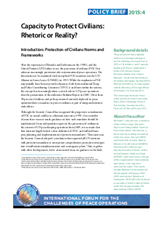POLICY BRIEF 2015:4 Capacity to Protect Civilians: Rhetoric or Reality?

After the experiences of Rwanda and Srebrenica in the 1990’s, and the United Nations (UN) failure to act, the protection of civilians (POC) has taken an increasingly prominent role in international peace operations. The first mission to be mandated with an explicit POC-mandate was the UN Mission in Sierra Leone (UNASIL) in 1999. While the emphasis on POC may initially have been met with reluctance, both from traditional Troop and Police Contributing Countries (T/PCCs) and from within the system, the concept has increasingly taken a central role in UN peace operations after the presentation of the milestone Brahimi Report in 2000. More than 98 percent of military and police personnel currently deployed in peace operations have a mandate to protect civilians, as part of integrated missionwide efforts.
The author of this paper, Ms Hilde F. Johnson, was a member of the UN Secretary-General’s High-Level Independent Panel on Peace Operations. Ms Johnson is the former Special Representative of the Secretary-General (SRSG) and Head of the United Nations Mission in South Sudan (UNMISS). Prior posts include Minister for International Development of Norway (1997-2005) and elected Member of Parliament (1993-2001).
This policy brief was originally written as a background paper for the Challenges Annual Forum 2015 on ‘Institution- and Capacity-building for Peace: Implications of the UN’s Review Panels’ Recommendations for Future Missions’, hosted by the Institute for National Strategic Studies (INSS), Ministry of Defence, in cooperation with the Ministry of Foreign Affairs of Armenia, 5-6 October 2015.

